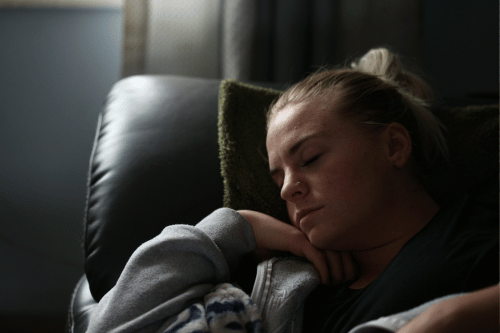Idaho, Iowa, Des Moines

If you’re neurodivergent (with the specific flavors of ADHD or autism), you probably already know that your brain doesn’t do well with too much or too little stimulation.
Your brain and body are constantly working to maintain neurodivergence homeostasis, a kind of internal balance where things feel safe, manageable, and just stimulating enough to keep you regulated. I call this the stimulation sensitivity ‘Goldilocks Zone’: not too much, not too little, but in the just-right zone.
This need for just right is one of the core struggles of living in a world that wasn’t built for your nervous system. Understanding how to better navigate the extreme ups and downs can help you find the middle ground.
Neurodivergent brains process stimulation differently. If you’re autistic or have ADHD (or both), your nervous system is more sensitive to input from the world around you. That means more information comes in, it hits harder, and it’s more difficult to filter out.
In other words, stimulation sensitivity is at the heart of neurodivergence.
This sensitivity can lead to:
The result is dysregulation. Your nervous system swings toward anxiety, irritability, shutdown, or dissociation. You might start doomscrolling, snapping at people, spiraling, or disappearing into yourself completely.
These reactions make sense, though, when you recognize them for what they are: your brain trying to find balance in a world that’s constantly throwing it off.

When your stimulation levels are balanced, your nervous system can finally relax. You feel grounded. Focused. Less hypervigilant.
This is why so many ADHDers and autistic folks crave routines, rituals, and familiar patterns. Predictability feels safe. It reduces the number of unknowns your brain has to deal with, and it gives you something to rely on when your inner world feels chaotic.
But the flip side of that is boredom. For people with ADHD in particular, routine can quickly start to feel dull. Your brain craves novelty and dopamine. So while routines help regulate you, they can also feel suffocating if there’s no stimulation to keep things interesting.
Cue the constant back-and-forth between “I need peace” and “I need something exciting to keep me going.” It’s like the difference between gentle waves lapping up on shore, easily manageable and still perfectly swimmable, vs. the violence of a tsunami and the wreckage it leaves in its wake. The tsunami is your nervous system swinging from one extreme to the other. The gentle lapping waves are the goal.
If you have anxiety and you’re neurodivergent – which is a combo I see a lot in my practice – finding the right amount of stimulation is an even tougher balance to strike.
Anxiety stems from a need for control. You want things to feel safe and predictable and known. That means you’re likely to double down on routines, plans, and structure, sometimes to the point of rigidity. But ADHD makes it easy to feel restless, distracted, or bored when things get too predictable. So you chase novelty. You sign up for more. You overcommit. You scroll. You overstimulate yourself back into chaos.
You end up in a weird whiplash loop of overstimulation leading to shutdown, which leads to understimulation, which leads to boredom, and then more overstimulation, and over and over it continues. As the cycle grows, it fuels emotional dysregulation, executive dysfunction, and a persistent sense of hypervigilance.
This pattern can wear you out. And because you don’t see other people struggling the same way, it can also make you feel broken and wrong.
You aren’t broken, wrong, or bad, but your nervous system does need extra care and understanding in order to maintain safety.
So how do you cope with all this?
You learn to walk the middle path. You learn what’s too much, what’s not enough, and how to steady yourself in the grey area. You build your life around that as much as you can.
And listen: I’m not advocating for finding the perfect balance and making yourself rigidly adhere to that at all times. Perfection doesn’t exist. And you’re a human, so rigidly adhering to anything challenging is often unsustainable in the long-term. However, you can start to better understand yourself and your needs, and to honor those as often as you can.
Here are some ways to start:
Begin to notice what overstimulates you and what understimulates you. Pay attention to what you’re doing, where you are, who you’re with, and how you feel before and after. Is there a sweet spot in the day where things feel steady? What about a time of day that feels hectic or hard? Are there situations that lead to either shutdown or frantic energy? Notice the patterns that arise. This will help you figure out how to tweak your environment or your expectations to better fit your needs.
Instead of cramming your life into a strict to-do list, try building a rhythm. What time of day do you focus best? When do you crash? When do you need movement or rest? Maybe these things change every day. If that’s the case, can you create a few routines to choose from can help you make the most of your days, rather than flailing in an attempt to find stability?
Giving your nervous system structure and flexibility helps you stay in the Goldilocks zone longer.

If you only focus on grounding, like we’ve talked about, you’ll get bored and restless, and it might even increase your anxiety. If you only chase dopamine, you’ll burn out. You need both. Ask yourself whether you tend to do one or the other more often, and how that impacts your mood and behaviors.
Try alternating activities: do something stimulating (like a walk, a podcast, a creative project) followed by something calming (like deep breathing, soft lighting, or quiet time). Think of it as weaving stimulation and rest together throughout your day.
You can’t control everything, but you can reduce unnecessary noise. Try the basics, like muting notifications, using noise-canceling headphones, wearing comfortable clothes, and paying attention to one task at a time as much as possible (i.e. don’t scroll while eating.) These are a few controllables that can make a big difference. Creating a more regulated baseline makes it easier to handle whatever the world throws at you.
Finding your balance isn’t a one-size-fits-all process. A therapist who understands the challenges and strengths that accompany neurodivergence can help you figure out how to cope.
If you’ve been stuck in the cycle of too much or too little, I want you to hear that you’re not failing. And you don’t need to change who you are to make it easier for everyone else. But finding your sweet spot can make it easier for you to navigate the world.
Therapy can help you find the stimulation sensitivity ‘Goldilocks Zone’, where your nervous system can finally chill out and you can feel more like yourself again. When you do start to swing, you’ll be able to recognize it more quickly and learn how to return to homeostasis.
If you want support, I’m here to help you recognize your patterns, explore new strategies, and give you permission to find better balance and belonging in the world. I’m a licensed therapist and coach for millennials with ADHD, autism, and anxiety, which means I get it. My clients are burned out from decades of masking, perfectionism, and people-pleasing, and they’re ready to create real change.
Reach out today to schedule a complimentary consultation and see if we’re a good fit. Let’s start building a better future together.
Danielle is an anxiety therapist and perfectionism coach. She specializes in helping busy millennials dial down their anxiety and ADHD, so they can perform at their best. Danielle has been featured on Apartment Therapy, SparkPeople, Lifewire, and Now Art World. When Danielle isn't helping her clients, she's playing video games or spending time with her partner and step children.

